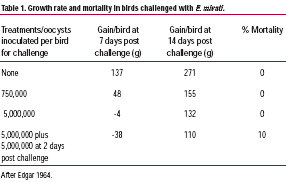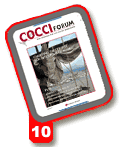Solving the E.Mivati Mystery
Recent research, testing indicate the once elusive coccidial pathogen is a distinct species.
 Fitz-Coy: 'E. mivati oocysts tend to be smaller and broadly ovoid"�'
|
For decades, Eimeria mivati "one
of nine species of Eimeria known
to cause coccidiosis in chickens
"has been a source of controversy
among poultry pathologists.
Some believed it to be a distinct
Eimeria species that posed a threat to
broilers, but others have been doubtful
and consider it either a variant of E.
acervulina or a mixture of the E.
acervulina and E. mitis species.
However, recent studies, conducted
by Dr. Steve Fitz-Coy of Schering-
Plough Animal Health Corporation, as
well as polymerase chain reaction testing,
indicate that E. mivati is a unique
type of Eimeria.
Studies also show that the prevalence
of E. mivati, based on litter sampling,
may be as high as 22% and that
it causes disease and performance loss
in chickens if not controlled.
Putting it in perspective
"For a long time, the issue of E. mivati
was not a major concern because anticoccidials
were effectively controlling
the primary pathogenic species of
Eimeria that threaten commercial chickens," says Dr. Rick Phillips, a veterinarian
at Schering-Plough Animal Health
Corporation.
"Any controversy about whether E.
mivati is a distinct species was primarily
one of academic interest, but it had
little practical relevance," he says.
Now, the situation is different, he
says.
With the shift from in-feed anticoccidials
to vaccination of chickens for
coccidiosis control, E. mivati has to be
considered. Anticoccidials control coccidiosis
by killing parasites, but vaccines
work by enabling chickens to
build immunity that naturally fights off
the disease, Phillips explains.
"Producers need to be sure that the coccidiosis vaccine they use protects against the major Eimeria species that cause disease in chickens, including E. mivati," he says.
Keep in mind, Phillips continues, that there is no cross-protection when it comes to Eimeria, he says."If chickens are immune to E. acervulina, they only have immunity against E. acervulina and, if exposed to E. mivati, they'll succumb to the new infection. "Immunity against one species doesn't protect against another," he says.
E. mivati history
E. mivati was first isolated in 1959 from
a poultry farm in Zephyr Hill, Florida,
by the late Dr. S. Allen Edgar, a world
renowned poultry pathologist from Alabama's Auburn University. Prior to
recognition of the parasite, the farm
had experienced persistent and unusual
outbreaks of coccidiosis.
For several years after his discovery,
Edgar conducted extensive research to
determine the characteristics of E.
mivati and validated its differences
from other chicken coccidia.
In 1964, E. mivati was added to the
list of coccidia affecting chickens when
Edgar published his findings.1
Subsequently, several researchers
reported finding E. mivati in other
countries, including Canada, Great
Britain, Germany and France.
By the 1970s, however, some
researchers began to question the existence
of E. mivati.
In 1973, P.L. Long of Houghton
Poultry Research Station (now the
Institute for Animal Health),
Huntingdon, England, concluded that
E. mivati was not sufficiently different
from E. acervulina to be a distinct
species and that it should be referred to
as E. acervulina var. mivati.2
Fitz-Coy, a parasitologist who worked with Edgar, says that the most influential report questioning the existence of E. mivati appeared in 1983, after Dr. Martin W. Shirley and associates, also of Houghton Poultry Research Station, used electrophoresis to study a potential field isolate of E. mivati provided by Auburn University.3
"They concluded that it was probably
a combination of E. acervulina and
E. mitis and should be considered
"nomina dubia" "in other words, its
existence is doubtful," he says.
The conclusions of that report stuck
and, long after it was published, many
researchers continued to question the
validity of E. mivati as a unique
species, says Fitz-Coy, now a technical
service representative for Schering-
Plough Animal Health. In subsequent
years, while anticoccidials were effectively
controlling coccidiosis, E. mivati
received little attention as a research
infectious agent; it just wasn't much of
a concern or it was lumped into an E.
acervulina-like category.
In addition, says Fitz-Coy, E. mivati
isn't as easy to work with as other coccidial
species such as E. acervulina, E.
maxima and E. tenella. The lesions of E.
acervulina and E. mivati are similar and
both "parasitize" some of the same
regions of the intestines. Most field isolates
are a composition of multiple
species of Eimeria. "All these factors
contribute to the difficulty in identifying
E. mivati," he says.
There are differences, however. "Traditionally, identification of coccidia
species is based on morphology,
pathology, the prepatent period and
cross-immunization evaluations. E.
mivati oocysts tend to be smaller and
are broadly ovoid compared with those
of E. acervulina," he says.
Further research
Not widely known is that Fitz-Coy continued research with E. mivati, though his findings were not always published.
Between 1988 and 1990, when Fitz-
Coy worked for the University of
Maryland, Eastern Shore, he isolated
three probable isolates of E. mivati.
They were obtained from commercial
broiler farms in the Delmarva region of
the United States. All three had similarities
to the E. mivati described by
Edgar, his mentor.
When Fitz-Coy immunized chickens
with E. acervulina and challenged them
with the E. mivati he had isolated, the
birds had no protection and developed
coccidiosis. But when he immunized
chickens with the E. mivati and challenged them with E. mivati, they had
good protection.
PCR testing
According to Phillips, the most compelling
evidence that E. mivati is a distinct
species comes from recent PCR
testing, a sensitive, state-of-the-art technique
that enables identification of
small DNA fragments.
Current PCR kits identify E. acervulina,
E. maxima, E. necatrix, E. mitis, E.
brunetti and E. tenella. When Fitz-Coy
provided blind or unidentified samples
of E. mivati and other species to a
research investigator for PCR testing,
the known species were identified, but
the E. mivati samples could not be
identified.
Fitz-Coy plans to publish his findings
with details, and an E. mivati PCRprimer
is currently being developed for
rapid identification purposes.
 Phillips: The current prevalence is probably underestimated"�'
|
Prevalence
For producers, the real significance of E. mivati, Phillips points out, is its prevalence in the field and its affect on flock performance.
In the early
1960s, Edgar had
found a 50% incidence
of E. mivati
organisms in samples
sent to Auburn
from Florida.
Fitz-Coy says, "Based on my observations
over the
years, study of field
isolates and routine
necropsy evaluations
of chickens from
commercial broilers
farms in the Atlantic,
Southeast and West Coast, organisms
that morphologically resemble those of
E. mivati are seen. They can appear in
great abundance and are found
throughout the entire small intestine."
From 2001 to 2004, Fitz-Coy analyzed
data from approximately 130
necropsy sessions in the United States,
and found 24 were positive for E.
mivati. In other words, 18% of the
necropsy cases were positive for E.
mivati. Between 2002 and 2004, when
he tested 55 litter samples from major
US broiler production areas, 12 were
positive for E. mivati, yielding a 22%
incidence, he says.
Phillips says, "The current prevalence
is probably underestimated
because E. mivati is under-recognized,
and even a 20% incidence is pretty significant."
Impaired weight gain, mortality
The consequences of E. mivati infection in chickens were evaluated by Edgar from the 1960s to 1980s and by Fitz-Coy since the late 1980s. Three of several E. mivati field isolates from Georgia and the Delmarva area were used. For each evaluator, groups of birds were inoculated with varying amounts of E. mivati oocysts to evaluate for growth rate and mortality, and one group was not inoculated and served as a control.The more E. mivati oocysts that birds received, the worse the outcome. For instance, 14 days after challenge, birds that received the most oocysts had an average weight gain per bird of 110g (0.24 lb) compared to 271g (0.60 lb) in controls.
None of the birds in the control group died, but in the group that received the strongest challenge, 10% died (see Table 1).
In a subsequent study conducted by Fitz-Coy, inoculation of naïve birds using an E. mivati isolate from North Carolina yielded a mortality of 50%. There was no pathology in hatch mates immunized with E. mivati against the isolate.
Pathologic changes
 Table 1. Growth rate and mortality in birds challenged with E. mivati.
|
Another way to demonstrate the pathogenicity
of E. mivati is by examining
the pathologic changes it causes in
chickens. E. mivati oocysts, says Fitz-
Coy, usually are found in intestines that
have been scored with mucoid and/or
watery enteritis. They are smaller
oocysts than those of E. acervulina, and
are broadly ovoid.
As far back a 1980, researchers
Norton and Joyner wrote in
Parasitology that they had found "clear
distinctions" between the damage done
by E. mivati and E. acervulina isolates.4
E. mivati produced scattered petechiae
(red spots), but the intestinal lesions
were not as prominent compared to
those seen with E. acervulina. The
manifestations of E. mivati were most
numerous in the lower small intestine
and proximal ceca.
In addition, the ratio of villus height
to total mucosal thickness in the lower
intestine was reduced with E. mivati,
while similar changes due to E.
acervulina were seen only in the anterior
intestine, Norton and Joyner said.
Fitz-Coy has no doubt that "E. mivati is pathogenic to chickens, resulting in impaired feed utilization, impaired growth and, sometimes, mortality depending on the level of challenge."
Phillips agrees and says, "E. mivati
is real. Be sure that the vaccine you are
using to control coccidiosis protects
against E. mivati. Coccivac-B has
always contained E. mivati and, currently,
is the only licensed commercial
vaccine that protects against this
Eimeria species.
"We didn't have to deal with E.
mivati before because anticoccidials
were controlling it, but it's safe to
assume that E. mivati resistance to
anticoccidials may be developing just
as it has for other Eimeria species. On
the plus side, we have an effective
method of control," he says.
Further PCR research is being aggressively pursued, Phillips adds. "Since E. mivati can affect poultry performance, we want to make sure that any questions about its existence are resolved once and for all. There's also still a lot to learn about this Eimeria species," he concludes.
References1 Edgar SA, Seibold, CT. A new coccidium of chickens, Eimeria mivati sp.n. (Protozoa:Eimeriidae) with details of its life history. Journal of Parasitology 1964:50;193-204.
2 Long PL. Studies on the relationship between Eimeria acervulina and Eimeria mivati. Parasitology 1973:67;143-155.
3 Shirley MW, Jeffers TK, Long PL. Studies to determine the taxonomic status of Eimeria mitis, Tyzzer 1929 and E. mivati, Edgar and Seibold 1964. Parasitology 1983:Oct;87(Pt 2):185-98.
4 Norton CC, Joyner LP. Studies with Eimeria acervulina and E. mivati: pathogenicity and cross-immunity. Parasitology 1980:Oct;81(2);315-23.







